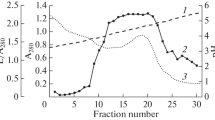Summary
Although Cryptococcus neoformans is not regarded as proteolytic, the sensitive technique of immunoelectrophoresis has demonstrated its ability to degrade human α2HS-glycoprotein and split up human as also pure cattle fibrinogen under in vitro conditions. If it is assumed that this organism exerts similar effects under in vivo conditions, then the present observations permit the explanation for the characteristic lack of fibrosis and hyalinization around tissue lesions in the disseminating form of the disease.
Zusammenfassung
Bisher war eine proteolytische Enzymaktivität bei Cryptococcus neoformans unbekannt. Mit Hilfe der Immunelektrophorese gelang uns der Nachweis, daß Cryptococcus neoformans in vitro sowohl das α2HS-Glykoprotein wie das Fibrinogen enzymatisch angreifen kann.
Damit wird erklärlich, weshalb Cryptococcus neoformans so reaktionslos im Wirtsorganismus wachsen kann : Die Schleimkapsel des Pilzes blockiert die humorale und celluläre Immunreaktion und durch die Fähigkeit zum Abbau von Fibrinogen wird jede Fibrinablagerung und damit auch die nachfolgende Fibrosierung verhindert.
Similar content being viewed by others
References
Bennett, J. D., Hasenclever, H. F.: Cryptococcus neoformans polysaccharide: studies of serologic properties and role in infection. J. Immunol.94, 916–920 (1965).
Bulmer, G. S., Sans, M. D., Gunn, C. M.: Cryptococcus neoformans. I. Nonencapsulated mutants. J. Bact.94, 1475–1479 (1967).
Bulmer, G. S., Sans, M. D.: Cryptococcus neoformans. II. Phagocytosis by human leukocytes. J. Bact.94, 1480–1483 (1967).
Drouhet, E., Segretain, G.: Inhibition de la migration leucocytaire in vitro par un polyoside capsulaire de Torulopsis (Cryptococcus) neoformans. Ann. Inst. Pasteur81, 674–678 (1951).
Drouhet, E., Segretain, G., Aubert, J.-P.: Polyoside capsulaire d'un champignon pathogène Torulopsis neoformans. Relation avec la virulence. Ann. Inst. Pasteur79, 891–900 (1950).
Haugen, R. K., Baker, R. D.: The pulmonary lesions in cryptococcosis with special reference to subpleural nodes. Amer. J. clin. Path.24, 1381–1390 (1954).
Kao, C. J., Schwarz, J.: Isolation of Cryptococcus neoformans from pigeon nests, with remarks on the identification of virulent cryptococci. Amer. J. clin. Path.27, 652–663 (1957).
Littman, M. L., Tsubura, E.: Effect of degree of encapsulation upon virulence of Cryptococcus neoformans. Proc. Soc. exp. Biol. (N. Y.)101, 773–777 (1959).
Matheis, H.: Die Cryptococcose (Torulose) des Nervensystems. Dtsch. Z. Nervenheilk.180, 595–639 (1960).
Morelli, R., Rosenberg, L. T.: Role of complement during experimental Candida infection in mice. Infect. & Immunity3, 521–523 (1971).
Müller, H. E.: Methodische Untersuchungen in vitro zur Einwirkung bakterieller Proteasen auf menschliche Plasmaeiweißkörper, dargestellt am Beispiel von Pseudomonas aeruginosa. Zbl. Bakt., I. Abt. Orig.216, 79–87 (1971).
Müller, H. E.: Immunelektrophoretische Untersuchungen zur Einwirkung bakterieller Enzyme auf menschliche Plasmaproteine. Zbl. Bakt., I. Abt. Orig.217, 254–274 (1971).
Salfelder, K.: Cryptococcosis. In: Handbuch der speziellen pathologischen Anatomie und Histologie. E. Uehlinger (Ed.). III. Bd. 5. Teil: The pathologic anatomy of mycoses, pp. 383–464. Berlin-Heidelberg-New York: Springer 1970.
Scheidegger, J. J.: Une microméthode de l'immunoélectrophorèse. Int. Arch. Allergy7, 103–110 (1955).
Seeliger, H. P. R.: Das kulturell-biochemische und serologische Verhalten der Cryptococcus-Gruppe. Ergebn. Mikrobiol.32, 23–72 (1959).
Sethi, K. K.: Impairment of immune response in mice by capsular polysaccharide from Cryptococcus neoformans. Proc. Vth Congress of the International Society for Human and Animal Mycology, pp. 256–257 (1971).
Smith, H.: Biochemical challenge of microbial pathogenicity. Bact. Rev.32, 164–184 (1968).
Staib, F.: Serum-proteins as nitrogen source for yeastlike fungi. Sabouraudia4, 187–193 (1965).
Author information
Authors and Affiliations
Additional information
This investigation was supported by the Deutsche Forschungsgemeinschaft. We thank Mrs. E. Lips for skilful technical assistance.
Rights and permissions
About this article
Cite this article
Müller, H.E., Sethi, K.K. Proteolytic activity of Cryptococcus neoformans against human plasma proteins. Med Microbiol Immunol 158, 129–134 (1972). https://doi.org/10.1007/BF02120478
Received:
Issue Date:
DOI: https://doi.org/10.1007/BF02120478




